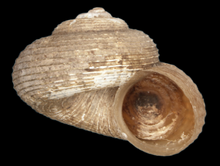| Amphicyclotulus dominicensis | |
|---|---|

| |
| Apical view of a shell of Amphicyclotulus dominicensis. Width of the shell is 13.2 mm. | |

| |
| Apertural view of a shell of Amphicyclotulus dominicensis. Width of the shell is 11.8 mm. | |
| Scientific classification | |
| Kingdom: | |
| Phylum: | |
| Class: | |
| (unranked): | |
| Superfamily: | |
| Family: | |
| Genus: | |
| Species: | A. dominicensis
|
| Binomial name | |
| Amphicyclotulus dominicensis | |
| Synonyms | |
|
Cyclotus amethystinus var. α Guppy, 1868 (in part)[2] | |
Amphicyclotulus dominicensis is a species of tropical land snail with a gill and an operculum, a terrestrial gastropod mollusk in the family Neocyclotidae.

Distribution
This species is endemic to the West Indian island of Dominica.[3]
The type locality is Long Dilton, Dominica.[1][3] The holotype is in National Museum of Natural History under number 535857.[3]
Shell description
Amphicyclotulus dominicensis has spiral cords which are clearly visible and raised.[3]
There are only two species in the genus Amphicyclotulus in Dominica.[3] The other species is Amphicyclotulus amethystinus, which has either no spiral threads or ones that are only weakly present.[3]
Amphicyclotulus dominicensis is smaller than the Amphicyclotulus amethystinus.[3] Amphicyclotulus dominicensis is more coarsely sculptured and has a higher spire.[3] It has been found on the leeward and windward sides of the island of Dominica, at low elevations only.[3]
References
This article incorporates CC-BY-3.0 text from the reference.[3]
- ^ a b Bartsch P. (1942). "The cyclophorid mollusks of the West Indies, exclusive of Cuba": 43-141. page 57, pl. 10 fig. 9-11. In: Torre C. de la, Bartsch P. & Morrison J. P. E. (1942). "The cyclophorid operculate land mollusks of America". Bulletin United States National Museum 181: 1-306, pls 1-42.
- ^ Guppy R. J. L. (1868). "On the terrestrial mollusks of Dominica and Grenada, with an account of some new species from Trinidad". Annals and Magazine of Natural History (4)1: 429-442.
- ^ a b c d e f g h i j Robinson D. G., Hovestadt A., Fields A. & Breure A. S. H. (July 2009). "The land Mollusca of Dominica (Lesser Antilles), with notes on some enigmatic or rare species". Zoologische Mededelingen 83 http://www.zoologischemededelingen.nl/83/nr03/a13 Archived 2011-10-07 at the Wayback Machine
